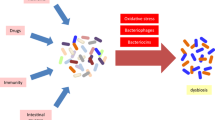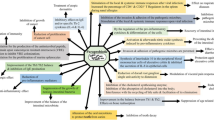Abstract
Infection of Giardia duodenalis is one of the most common human parasitic disease worldwide. This infection may be related to important changes in the enteric nervous system. The objective of this study was to evaluate the myenteric and submucosal plexuses, the intestinal muscle layer, and gastrointestinal transit in mice infected with assemblages A and B of G. duodenalis. Swiss albino mice (Mus musculus) were infected with assemblages A and B of G. duodenalis for 15 days. Gastrointestinal transit time was evaluated before euthanasia. Duodenum and jejunum were removed for histological and immunohistochemical analyses. It was observed a reduction in the enteric glial cell count and a decrease in the ratio of enteric glial cells to neurons. The number of neurons did not change, but morphological changes were observed in the duodenum and jejunum in both plexuses, including an increase in the nuclear area and a reduction of cell bodies in the myenteric plexus and a decrease in the nuclear area in the submucosal plexus. A reduction of the thickness of the muscle layer was observed in the duodenum, with no significant differences in the gastrointestinal transit times. Assemblages A and B of G. duodenalis decrease the number of enteric glial cells in the myenteric and submucosal plexuses, decrease the thickness of the muscle layer, and change the morphology of neurons.

ᅟ




Similar content being viewed by others
References
Almeida-Leite CM, Silva ICC, Galvão LMC, Arantes RME (2014) Sympathetic glial cells and macrophages develop different responses to Trypanosoma cruzi infection or lipopolysaccharide stimulation. Mem Inst Oswaldo Cruz 109:459–465
Ankarklev J, Jerlström-Hultqvist J, Ringqvist E, Troell K, Svärd SG (2010) Behind the smile: cell biology and disease mechanisms of Giardia species. Nat Rev Microbiol 8:413–422
Araújo EJA, Zaniolo LM, Vicentino SL, Góis MB, Zanoni JN, Silva AV et al (2015) Toxoplasma gondii causes death and plastic alteration in the jejunal myenteric plexus. World J Gastroenterol 21:4829–4839
Atherton R, Bhavnani D, Calvopiña M, Vicuña Y, Cevallos W, Eisenberg J (2013) Molecular identification of Giardia duodenalis in Ecuador by polymerase chain reaction-restriction fragment length polymorphism. Mem Inst Oswaldo Cruz 108:12–515
Aydin AF, Besirbellioglu BA, Avci IY, Tanyuksel M, Araz E, Pahsa A (2004) Classification of Giardia duodenalis parasites in Turkey into Groups A and B using restriction fragment length polymorphism. Diagn Microbiol Infect Dis 50:147–151
Bielefeldt-Ohmann H, Tolnay AE, Reisenhauer CE, Hansen TR, Smirnova N, Campen HV (2008) Transplacental infection with non-cytopathic bovine viral diarrhoea virus types 1b and 2: viral spread and molecular neuropathology. J Comp Pathol 138:72–85
Braga-Silva CF, Suhett CSR, Drozino RN, Moreira NM, Sant’Ana DDMG, Araújo SM (2016) Biotherapic of Toxoplasma gondii reduces parasite load, improves experimental infection, protects myenteric neurons and modulates the immune response in mice with toxoplasmosis. Eur J Integr Med 8:865–874
Calcina F, Barocelli E, Bertoni S, Furukawa O, Kaunitz J, Impicciatore M, Sternini C (2005) Effect of n-methyl-d-aspartate receptor blockade on neuronal plasticity and gastrointestinal transit delay induced by ischemia/reperfusion in rats. Neuroscience 134:39–49
Casavechia MTG, Lonardoni MVC, Venazzi EAS, Campanerut-Sá PAZ, Benalia HRC, Mattiello MF et al (2016) Prevalence and predictors associated with intestinal infections by protozoa and helminths in southern Brazil. Parasitol Res 115:2321–2329
Colli CM, Bezagio RC, Nishi L, Ferreira EC, Falavigna-Guilherme AL, Gomes ML (2015) Food handlers as a link in the chain of transmission of Giardia duodenalis and other protozoa in public schools in southern Brazil. Trans R Soc Trop Med Hyg 1:1–3
Creuzet C, Robert F, Roisin MP, Tan HV, Benes C, Dupouy-Camet J et al (1998) Neurons in primary culture are less efficiently infected by Toxoplasma gondii than glial cells. Parasitol Res 84:25–30
David EB, Guimarães S, Oliveira AP, Oliveira-Sequeira TCG, Bittencourt GN, Nardi ARM et al (2015) Molecular characterization of intestinal protozoa in two poor communities in the state of São Paulo, Brazil. Parasit Vectors 8:1–12
Dizdar V, Gilja OH, Hausken T (2007) Increased visceral sensitivity in Giardia-induced postinfectious irritable bowel syndrome and functional dyspepsia. Effect of the 5HT3-antagonist ondansetron. Neurogastroenterol Motil 19:977–982
El Basha NR, Zaki MM, Hassanin OM, Rehan MK, Omran D (2016) Giardia assemblages A and B in diarrheic patients: a comparative study in Egyptian children and adults. J Parasitol 102:69–74
Falkowski GJS, Sandri PF, Tiyo R, Aleixo DL, Araújo SM (2012) Parameters for evaluation of clinical trial in mice infected with Trypanosoma cruzi. Arq Bras Med Vet Zootec 64:1539–1546
Fantinatti M, Bello AR, Fernandes O, Da-Cruz AM (2016) Identification of Giardia lamblia assemblage E in humans points to a new anthropozoonotic cycle. J Infect Dis 214:1256–1259
Faust EC, Sawitz W, Tobie J, Odom V, Peres C, Lincicome DR (1939) Comparative efficiency of various technics for the diagnosis of protozoa and helminths in feces. J Parasitol 25:241–262
Góis MB, Hermes-Uliana C, Zago MCB, Zanoni JN, Silva AV, Miranda-Neto MH et al (2016) Chronic infection with Toxoplasma gondii induces death of submucosal enteric neurons and damage in the colonic mucosa of rats. Exp Parasitol 164:56–63
Grover M, Camilleri M, Smith K, Linden DR, Farrugia G (2014) On the fiftieth anniversary. Postinfectious irritable bowel syndrome: mechanisms related to pathogens. Neurogastroenterol Motil 26:156–167
Grubišić V, Gulbransen BD (2017) Enteric glia: the most alimentary of all glia. J Physiol 595:557–570
Halliez MCM, Buret AG (2015) Gastrointestinal parasites and the neural control of gut functions. Front Cel Neurosci 9:1–20
Khen-Dunlop N, Sarnacki S, Victor A, Grosos C, Menard S, Soret R, Goudin N, Pousset M, Sauvat F, Revillon Y, Cerf-Bensussan N, Neunlist M (2013) Prenatal intestinal obstruction affects the myenteric plexus and causes functional bowel impairment in fetal rat experimental model of intestinal atresia. PLoS One 8:e62292
Kim SE, Chang L (2012) Overlap between functional GI disorders and other functional syndromes: what are the underlying mechanisms? Neurogastroenterol Motil 24:895–913
Kumar V, Abbas A, Aster J (2014) Robbins & Cotran Pathologic Basis of Disease. Elsevier, Philadelphia
Li E, Zhao A, Shea-Donohue T, Singer SM (2007) Mast cell-mediated changes in smooth muscle contractility during mouse giardiasis. Infect Immun 75:4514–4518
Lucero MS, Mirarchi F, Goldstein J, Silberstein C (2012) Intraperitoneal administration of Shiga toxin 2 induced neuronal alterations and reduced the expression levels of aquaporin 1 and aquaporin 4 in rat brain. Microb Pathog 53:87–94
Mariano APM, Santos EN, Santos TN, Mota TN, Silva JA, Carvalho SMS et al (2015) Parasites in South Bahia: focus on giardiasis and ascariasis among preschoolers of Itabuna. Int J Health Sci 3:61–75
Martínez-Gordillo MN, González-Maciel A, Reynoso-Robles R, Montijo-Barrios E, Ponce-Macotela M (2014) Intraepithelial Giardia intestinalis: a case report and literature review. Medicine 93:e277–e277
Matsuchita HLP, Pitz AF, Melanda FN, Bregano RM, Oliveira FJA, Mori FMRL et al (2017) Descriptive molecular epidemiology study of Giardia duodenalis in children of Parana State, Brazil. Int J Epidemiol Res 4:1–9
Nunes BC, Pavan MG, Jaeger LH, Monteiro KJL, Xavier SCC, Monteiro FA et al (2016) Spatial and molecular epidemiology of Giardia intestinalis deep in the Amazon, Brazil. PLoS One 11:e0158805
Odorizzi L, Moreira NM, Gonçalves GF, Silva AV, Sant’Ana DMG, Araújo EJ (2010) Quantitative and morphometric changes of subpopulations of myenteric neurons in swines with toxoplasmosis. Auton Neurosci Bas Clinic 155:68–72
Painter JE, Gargano JW, Collier SA, Yoder JS (2015) Giardiasis surveillance—United States, 2011–2012. MMWR Surveill Summ 64:15–25
Panizzon CPDNB, Zanoni JN, Hermes-Uliana C, Trevizan AR, Sehaber CC, Pereira RVF, Linden DR, Neto MHM (2016) Desired and side effects of the supplementation with l -glutamine and l -glutathione in enteric glia of diabetic rats. Acta Histochem 118(6):625–631
Parlog A, Schlüter D, Dunay IR (2015) Toxoplasma gondii-induced neuronal alterations. Parasite Immunol 37:159–170
Pestechian N, Rasekh H, Rostami-Nejad M, Yousofi HA, Hosseini-Safa A (2014) Molecular identification of Giardia lamblia; is there any correlation between diarrhea and genotyping in Iranian population? Gastroenterol Hepatol Bed Bench 7:168–172
Pinheiro IO, Castro MF, Mitterofhe A, Pires FAC, Abramo C, Ribeiro LC et al (2011) Prevalence and risk factors for giardiasis and soil-transmitted helminthiasis in three municipalities of Southeastern Minas Gerais State, Brazil. Parasitol Res 108:123–1130
Rassi A, Rassi Jr A, Marin-Neto JA (2010) Chagas disease. Lancet 375:1388–1402
Rogers-Cotrone T, Burgess MP, Hancock SH, Hinckley J, Lowe K, Ehrich MF, Jortner BS (2010) Vacuolation of sensory ganglion neuron cytoplasm in rats with long-term exposure to organophosphates. Toxicol Pathol 38:554–559
Savioli L, Smith H, Thompson A (2006) Giardia and Cryptosporidium join the ‘neglected diseases initiative. Trends Parasitol 22:203–208
Silveira ABM, Lemos EM, Adad SJ, Correa-Oliveira R, Furness JB, Reis DD (2007) Megacolon in Chagas disease: a study of inflammatory cells, enteric nerves, and glial cells. Hum Pathol 38:1256–1264
Steinkamp M, Gundel H, Schulte N, Spaniol U, Pflueger C, Zizer E et al (2012) GDNF protects enteric glia from apoptosis: evidence for an autocrine loop. BMC Gastroenterol 12:1–7
Tamer GS, Kasap M, Er DK (2015) Genotyping and phylogenetic analysis of Giardia duodenalis isolates from turkish children. Med Sci Monit 21:526–532
Thompson RC, Ash A (2016) Molecular epidemiology of Giardia and Cryptosporidium infections. Infect Genetics Evol 40:315–323
Ventura LL, Oliveira DR, Viana JC, Santos JF, Caliari MV, Gomes MA (2013) Impact of protein malnutrition on histological parameters of experimentally infected animals with Giardia lamblia. Exp Parasitol 133:391–395
Vicentino-Vieira SL, Góis MB, Trevizan AR, de Lima LL, Leatte EP, de Melo GDAN et al (2017) Toxoplasma gondii infection causes structural changes in the jejunum of rats infected with different inoculum doses. Life Sci 191:141–149
Wensaas KA, Hanevik K, Hausken T, Eide GE, Langeland N, Mørch K, Rortveit G (2016) Postinfectious and sporadic functional gastrointestinal disorders have different prevalences and rates of overlap: results from a controlled cohort study 3 years after acute giardiasis. Neurogastroenterol Motil 28:1561–1569
Acknowledgements
We would like to thank the Programa de Pós Graduação em Biociências e Fisiopatologia, Universidade Estadual de Maringá, for incentivizing the development of this research and the Centro Universitário Integrado for providing the infrastructure to perform the experiments.
Author information
Authors and Affiliations
Corresponding author
Ethics declarations
The study was conducted based on the guidelines of the Sociedade Brasileira de Ciência em Animais de Laboratório and was approved by the Comissão de Ética em Experimentação Animal of the Centro Universitário Integrado (Statement no. 1070).
Conflict of interest
The authors declare that they have no conflict of interest.
Additional information
Section Editor: Panagiotis Karanis
Rights and permissions
About this article
Cite this article
Pavanelli, M.F., Colli, C.M., Bezagio, R.C. et al. Assemblages A and B of Giardia duodenalis reduce enteric glial cells in the small intestine in mice. Parasitol Res 117, 2025–2033 (2018). https://doi.org/10.1007/s00436-018-5853-3
Received:
Accepted:
Published:
Issue Date:
DOI: https://doi.org/10.1007/s00436-018-5853-3




